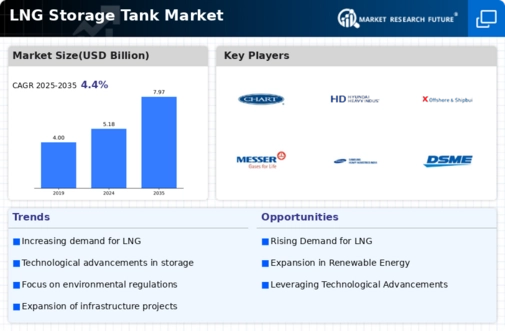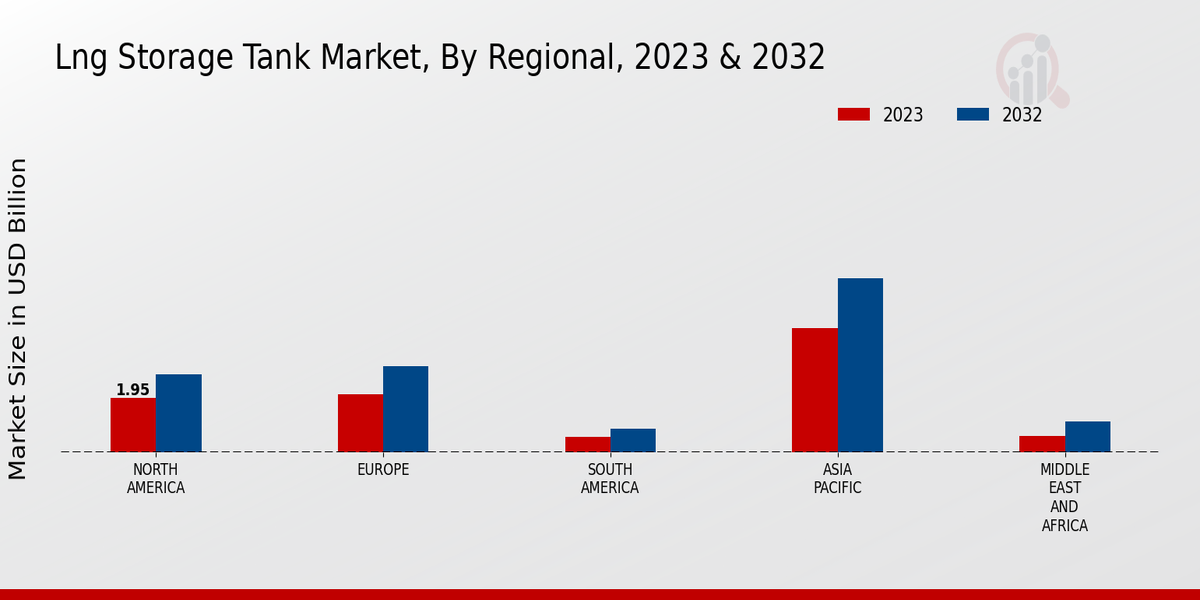Market Growth Projections
The Global LNG Storage Tank Market Industry is poised for substantial growth, with projections indicating a market size of 5.18 USD Billion in 2024 and an anticipated increase to 7.97 USD Billion by 2035. This growth reflects a compound annual growth rate (CAGR) of 3.99% from 2025 to 2035, driven by various factors including rising demand for natural gas, technological advancements, and supportive government policies. The market dynamics suggest a robust future for LNG storage solutions, as stakeholders adapt to the evolving energy landscape and seek to enhance their infrastructure capabilities.
Rising LNG Exports and Trade
The Global LNG Storage Tank Market Industry is benefiting from the increasing volume of LNG exports and international trade. As countries like the United States and Australia ramp up their LNG production, the need for efficient storage solutions becomes paramount. The expansion of global trade routes and the establishment of new LNG terminals are facilitating this growth. The market is projected to grow at a CAGR of 3.99% from 2025 to 2035, indicating a robust demand for storage tanks that can accommodate the rising export volumes. This trend underscores the importance of strategic investments in storage infrastructure.
Increasing Demand for Natural Gas
The Global LNG Storage Tank Market Industry is experiencing a surge in demand for natural gas, driven by the transition towards cleaner energy sources. Countries are increasingly investing in LNG infrastructure to meet their energy needs while reducing carbon emissions. For instance, in 2024, the market is projected to reach 5.18 USD Billion, reflecting the growing reliance on LNG as a viable alternative to coal and oil. This trend is expected to continue, with the market anticipated to expand further as nations commit to sustainability goals and seek to diversify their energy portfolios.
Technological Advancements in Storage Solutions
Innovations in LNG storage technology are playing a pivotal role in the Global LNG Storage Tank Market Industry. Enhanced insulation materials and advanced containment systems are improving the efficiency and safety of LNG storage. For example, the development of membrane tanks has allowed for greater storage capacity and reduced boil-off rates. These advancements not only optimize operational costs but also align with regulatory standards for safety and environmental protection. As a result, the market is likely to benefit from these technological improvements, fostering growth and attracting investments.
Government Policies Supporting LNG Infrastructure
Government initiatives aimed at promoting LNG infrastructure development are significantly influencing the Global LNG Storage Tank Market Industry. Many countries are implementing favorable policies and incentives to encourage investments in LNG terminals and storage facilities. For instance, regulatory frameworks that streamline permitting processes and provide financial support are becoming more common. This supportive environment is expected to drive market growth, with projections indicating a market size of 7.97 USD Billion by 2035. Such policies not only enhance energy security but also contribute to economic growth by creating jobs and stimulating local economies.
Growing Investment in Renewable Energy Integration
The integration of renewable energy sources with LNG infrastructure is emerging as a key driver in the Global LNG Storage Tank Market Industry. As the energy landscape evolves, there is a growing need for flexible storage solutions that can accommodate fluctuations in energy supply and demand. LNG serves as a complementary resource to renewables, providing backup during periods of low generation. This synergy is likely to attract investments in LNG storage facilities, enhancing their role in a diversified energy mix. The market's growth trajectory suggests a promising future as stakeholders recognize the potential of LNG in supporting renewable energy goals.




















Leave a Comment